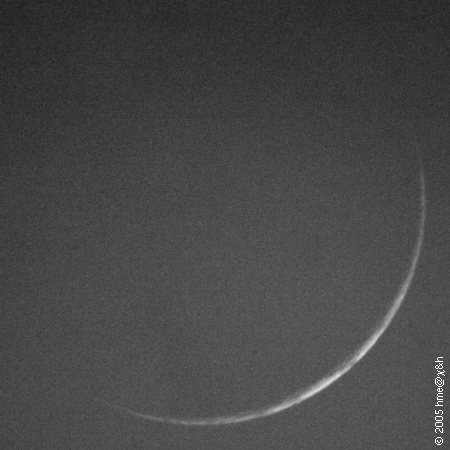
{
Practical astronomy
|
Astronomy
|
The Moon
|
Physical ephemeris
|
Phases
}
Phases
The triangle formed by Sun, Earth and Moon changes continuously: The Moon revolves around the Earth in 27.3 days, while the Earth drags it along in its own revolution around the Sun once a year. As a result, the overlap between the bright – Sun-facing – half of the Moon and the near – Earth-facing – half of the Moon changes with a period of 29.5 days. At Full Moon, the two coincide: The Earth is between Sun and Moon, the Moon appears fully in sunlight, and it is above the horizon all night and not at all during the day. At New Moon the Moon is between Earth and Sun, we cannot see it in the bright daylight, it is below the horizon all night, and if we could see it, we would see only its dark side.
The image is a montage of images collected over a few years, showing the change of this lunar phase roughly from one day to the next. At some New Moons the alignment is so precise that the Moon actually covers part or all of the Sun. In the montage the New Moon at the start is an annular eclipse, the one at the end a total eclipse.
The Gregorian calendar months have different length that do not match the lunar phases. Months are a secondary feature of that calendar, the main units are the year and the day. The Islamic calendar, on the other hand, is a pure lunar calendar and adjusted according to observations of the lunar crescent after New Moon. The second image here was taken just after the end of the 30th day of Muharram and the start of the first day of Safar of the Islamic year 1426 AH.
Physical parameters:
- Average distance: 384,000 km
- Radius: 1740 km
- Mass: 1/81 MEarth
- Surface gravity: 1/6 gEarth
The phases of the Moon are very easy to observe. Difficulties are presented by the very thin crescents, which are less bright and have to be observed in rather bright twilight skies. The evening (morning) crescent is best observed in spring (autumn), when the altitude difference to the Sun is greatest. Imaging should be relatively easy, the twilight sky and the Moon itself are not much fainter than a daytime landscape, so that exposures will be quite short. A long focal length is required, and hence also a tripod.
Image parameters:
- Camera: Canon EOS 300D
- Detector: 22 × 15 mm
- Focal length: 800 mm
- Field of view: 1 × 1°
- Aperture: f/12.6
- ISO: 400
- Exposure: 5 ms


